Intel Centrino/Pentium-M Notebook Roundup: Dell, FIC and IBM Examined
by Matthew Witheiler on March 12, 2003 11:22 AM EST- Posted in
- Laptops
IBM ThinkPad T40 - Under the Hood
First we will take a look at the IBM ThinkPad T40 72U, IBM's Centrino solution. The system comes configured with at 1.5GHz Intel Pentium M processor, 256MB PC2100 DDR memory, a 40GB 5400RPM hard drive, a DVD/CD-RW combo drive, an Intel PRO/Wireless Network Connection 802.11b wireless mini-PCI card, the Intel 855PM chipset solution, and ATI Mobility Radeon 7500 graphics. We would say that the system is well outfitted considering the limited amount of space IBM had to work with. The system fits the Centrino naming requirements by using the Pentium M processor, 855MP chipset, and an Intel wireless product.
Like the other units in this roundup the ThinkPad T40 is powered by the new Intel Pentium M processor which we discuss in detail here. The breed found in the T40 runs at 1.5GHz and is not one of the low volt or ultra low volt Pentium M solutions.
The CPU is cooled via a very small heatsink and fan assembly similar to the cooling solutions employed by the other Pentium M notebooks we have gotten a chance to see. The heatsink covers the processor only and is connected to a thin row of heatsink blades via two heat pipes which run from the processor core to the fined surface. The bottom of the heatsink makes contact with the Pentium M core via a small amount of thermal grease. There is a small area that extends off the side of the heatsink. This is the cool air intake port which the fan sucks air in from and exhausts over the heatsink surface. The foam around the heatsink edges helps prevent warm air from entering the cooling system.
The vast majority of the time the fan on the T40 was idle or running at such a low speed that it was essentially silent. In fact, even under stressful situations that would typically result in a high fan speed, the T40's cooling solution remained quiet.
Also like the other systems in this roundup, the T40 uses an Intel 855PM chipset solution. Again, we already took an in depth look at the 855PM chipset in our Pentium M processor review, so read up on that if you have any technical questions on the new Intel mobile solution.
Both the north bridge and the south bridge are located on the top of the T40's motherboard. Neither is actively cooled via a fan nor are the parts cooled via a heatsink. This proves that no heatsink solution is needed on either the 855PM's north bridge or the south bridge, something that is not true of previous generation Intel chipsets.
Removing the heatsink/fan assembly and the CPU shows that the processor sits in a standard molex type socket meaning that the chip can be removed and placed back in via a simple twist of a screw. You may notice that the socket is the same type used on Pentium 4 and Pentium 4-M processors. Although the pin configuration of the Pentium M is slightly different than that of the Pentium 4 the processor does fit in the same socket. As the Dell dissection shows, there are molex sockets designed specifically for the Pentium M.
Mounted below and to the right of the processor is the T40's video solution:
a Mobility Radeon 7500. You may recall that the Mobility Radeon 7500 is a mobile
version of the desktop Radeon 7500, meaning that the chip does have 3D capabilities
but they are somewhat limited compared to other mobile 3D solutions (read up
on the Radeon 7500
The video chip is not cooled actively or passively; the chip just sits exposed to the air flowing around the system.

With all these chips located near the middle of the motherboard in a fairly
compact area, the other logic chips on the T40 are spread around the system.
Another cluster of chips can be seen in the upper left portion of the picture
below. Here lie the Texas Instruments
On the far right in the picture below one can make out the Intel RC82540EP
Gigabit ethernet controller, a National Semiconductor Super I/O controller,
and an Analog Devices
Also on the front of the motherboard is one of the system's two SODIMM slots. In the T40 this bank, which is not user accessible, is populated with 256MB of PC2100 DDR memory.
The mini-PCI connector is also located on the top of the motherboard. We already know that the T40 uses the Pentium M processor and 855PM chipset and it is the wireless card which populates this mini-PCI slot that makes the T40 a full Centrino notebook. The system comes with an Intel Pro/Wireless Network Connection 802.11b card, model number WM3B2100. Unlike some other Intel wireless cards we have seen, the new WM3B2100 is made by Intel and uses an Intel controller (chip number 82531ME). IBM utilizes both antenna connections available on the wireless card. Each antenna is mounted in the space around the LCD display.
The top side of the T40's motherboard is packed, producing one of the smallest motherboards we have seen. In the picture below the motherboard has been rotated 90 degrees clockwise to make it fit better on the page. What you are seeing at the top of the picture is actually the motherboard's left side.
With all the components mounted on the top side of the T40 it should be no surprise that the bottom side of the motherboard is essentially devoid of logic chips. The only item of note on the back of the motherboard is the second SODIMM socket which is user accessible for future upgrades.
We were pleased to find that the T40 also uses a 5400RPM hard drive. The solution
that the T40 employs is a
Speaking of hard drives, we noticed that a new feature of the T40 series notebooks is the "IBM Integrated HDD Shock Absorber" which "offers impact protection for the hard disk drive." What is this shock absorber which IBM speaks so highly of? Dissection revealed that the "Integrated HDD Shock Absorber" simply a thin rubber pad that sits above below the hard drive while in the system. Judging by the pads size, it is unlikely that the shock protection system will do much to prevent hard drive damage during a fall or large jolt.


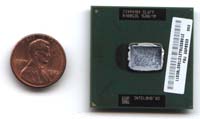
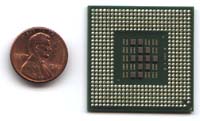

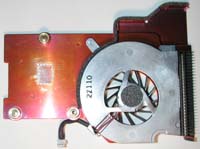


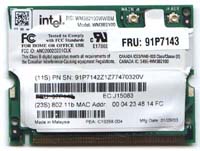
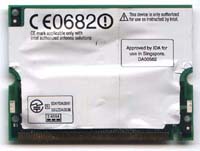
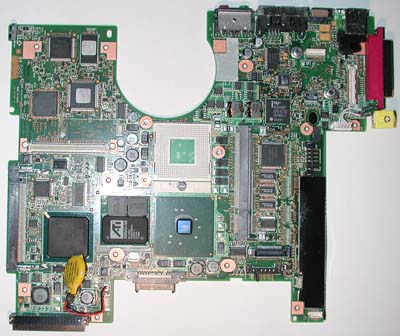
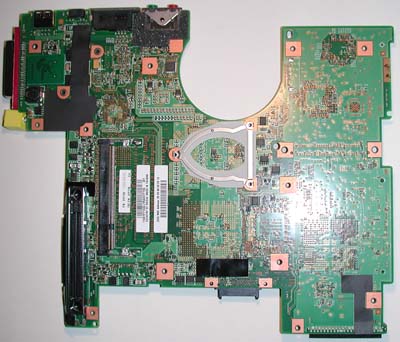
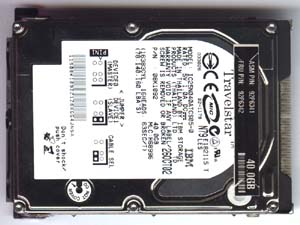
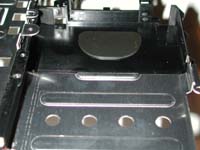
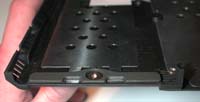









3 Comments
View All Comments
builda - Thursday, February 2, 2006 - link
There appears to be a wide spread fault with the Gigabyte NB-1401 model notebook, where it reports having system disk errors or cannot find the hard disk. We have 7 of this model notebook and now 6 of them have reported the same problem. After running chkdsk to temporarily repair the errors that had been caused on the harddisk I found the problem returned the escalated to the point the harddisk could not be found. I further checked using Hitachi drive fitness testing tool which reported a cable error on each machine. Originally I returned 3 of these for repair as they were just outside the warranty period and the supplier checked with Gigabyte with the fix being to rub the cable all over with an eraser!! This worked for a short period but the problem has returned a couple of months later and has spread (like a virus) it now affects 6 out of the 7 notebooks. The supplier has just gone into administration and my next step is to approach Gigabyte who's support service has been found to be extremely unresponsive in the recent past.dbiberdorf - Tuesday, July 27, 2004 - link
I beg to differ with the reviewer. The keyboard on this unit is mediocre, and the track stick buttons are an abomination. They sit too low in the case and have too much travel. It makes my thumbs hurt after a while, and I often have to press them with a finger to get them to activate fully.The most powerful notebook in the world loses big points in my book if they built-in keyboard and pointing devices are weak. Certainly it's the case here. Dell, please figure out how to buy good keyboards for your machines!
Finally, the power adapter, while featuring convienent wrap-around cabling, is phenomenally large. My cordless phone at home is smaller. With the large profile of the machine, the adapter has to go in a side pocket of the carrying case, adding a little more bulge to your day.
visibilityunlimited - Thursday, October 30, 2003 - link
Screen resolution beyond SXGA+ would be unreadable using Windows for example while being more readable using Linux.Both the Linux text console and graphics mode X-windows-system screen drivers can be fully customized to display text at any resolution. The text characters could easily be displayed with current software at 1200dpi or more (if only the graphics processors and monitors could operate at that speed) and still retain the current character size. Text can currently be generated from vector based Type I and TrueType fonts for rasterizing at any resolution. Image scaling is a different and very easy problem.
The Windows OS is the real culprit holding back general usage of higher resolutions and typeset quality displays because of the OS being handicapped by the inertia of antique display modes. Darn. I want 3200x2400 or more!